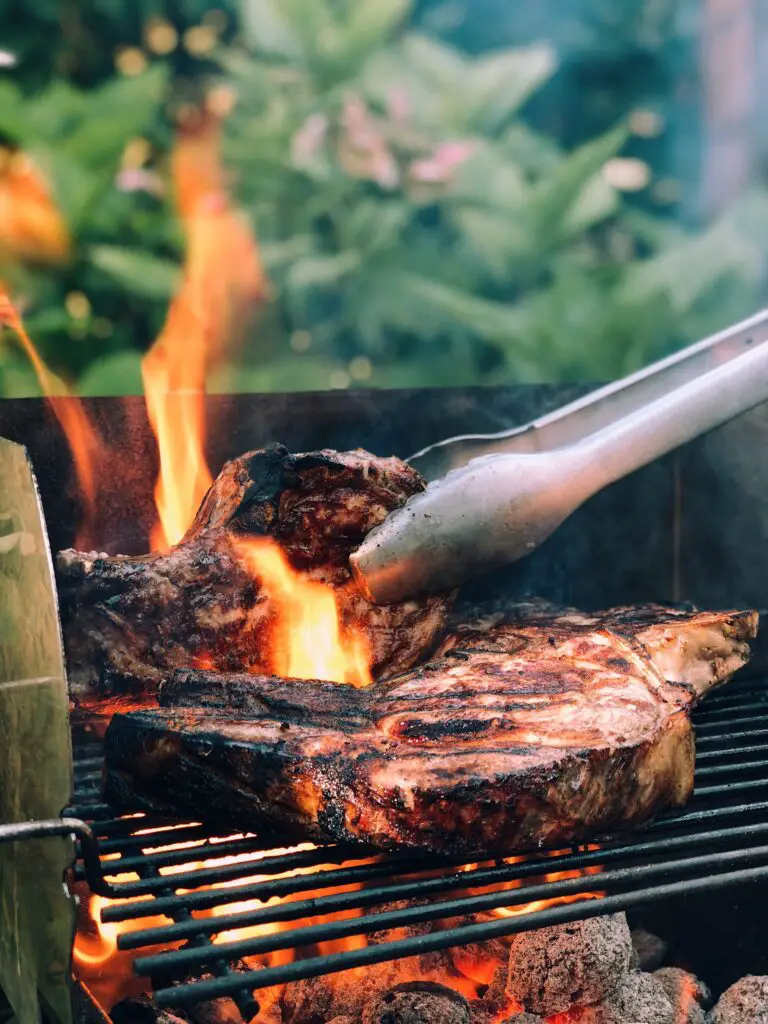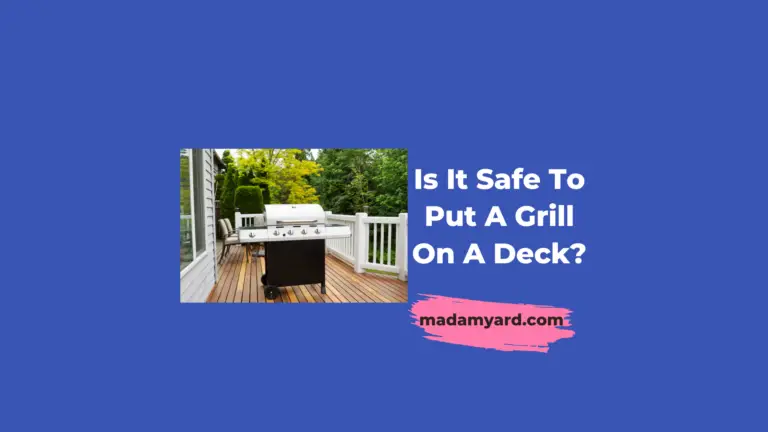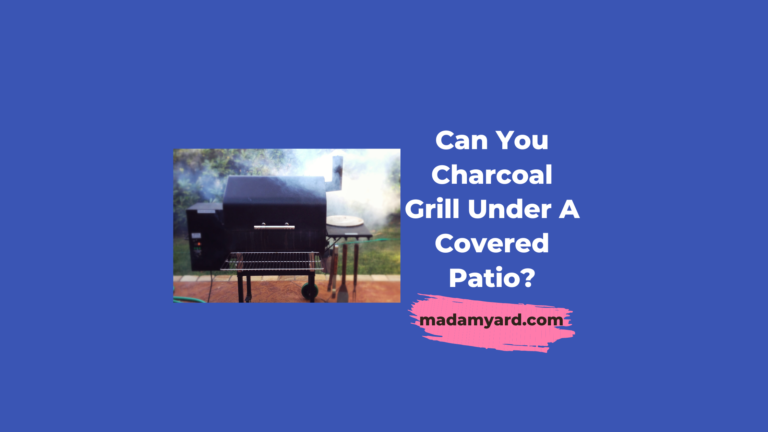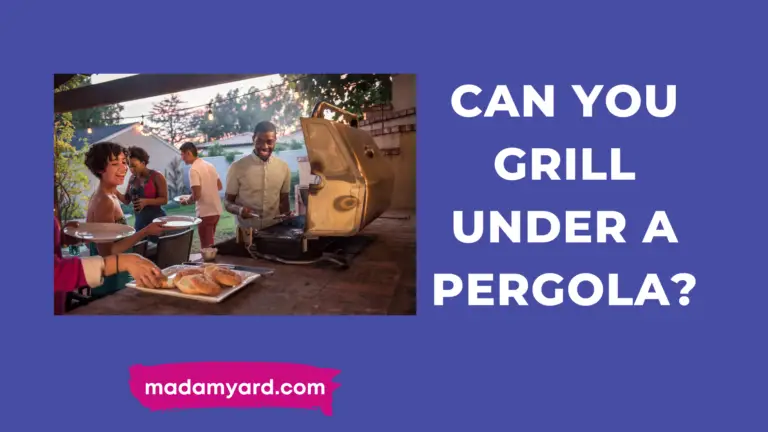Can You Put a Grill Under Gazebo?
Grilling in the backyard under a gazebo sounds like a good idea. But have you taken into consideration the potential damage that could result from grilling under your gazebo? Some could argue that it keeps the area warm, while others might say it allows you to appreciate the dish after it’s finally off the grill. So, can you put a grill under gazebo?
It is not suggested to use a barbecue or grill under a gazebo for safety reasons due to a lack of clearance and ventilation in the structure. Barbecuing beneath a gazebo is a fire hazard and a risk to the chef and any guests around or under the gazebo, making it unsafe.
Suppose your gazebo is a basic style with no blinds, no combustible materials, and plenty of open space. In that case, you might be able to get away with barbecue — as long as you follow the safety procedures that are in place. Continue reading for guidelines and safety measures for safe grilling.

What is a Gazebo and The Uses
A gazebo is a pavilion structure, sometimes octagonal or turret-shaped, used as a vantage point to view the surrounding area. A gazebo is usually built in a garden or a park. It can also be built in a yard.
Gazebos are often used as a place to live outside, providing shade and shelter from the sun and rain. Party, celebration, and picnic: They can be used for these things and other things.
How Do You Put a Grill Gazebo Together?
This is an excellent way to spend your weekend. You should think about how you want to spend your time. The right tools and someone to help if you buy a hardtop grill are essential.
It is advisable to build a barbecue gazebo on a hard surface, such as stone or pavers, and locate it in an exact location unless you do not mind your gazebo tilting.
Most gazebos come with instructions from the manufacturer. If you follow these, your gazebo should be done right.
Installing a gazebo is easy when you follow these tips.
- Start by reading all the directions, from beginning to end, to anticipate what to expect.
- In this way, you will be aware of the tools and help you require in advance of the project.
- Lay everything out to make sure you have all the parts you need.
- If you’re making a hardtop, start assembling it on the ground. This is easier than building the top from above.
- Choose a day when the weather is good so that you can enjoy a tasty grilled meal afterward.
How Far Should my Grill be From my House
US Consumer Product Safety Commission says that you should keep the grill at least 10 feet away from your house, garage or breezeway. You should also keep it away from a surface that will burn.
It’s also essential to keep the grill at least two feet away from your house because it can catch fire.
When you keep this distance between your house and the grill, you will be on the safe side if there is a fire while you’re grilling.
The recommended distance between you and the grill should be kept. Also, this will keep smoke and smells from coming into your house.
Finding a flat, open spot away from your home, outbuildings, and trees would be ideal. It’s also essential to think about what your neighbors will think. They don’t want a yard full of smoke.
When you choose a place for your grill gazebo, other things to think about could be how much sunlight it gets: does it get enough, but not too much, or too little? Is the site open or covered? Are there any trees that might get in the way? Never forget that a high-quality gazebo will last for many years, allowing for the growth of trees in the area around it.
Does it enhance or detract from the view from your windows? Even though most gazebos are stunning buildings, you may not want one to obstruct your idea of a beloved tree or flower bed in your backyard.
Do you think the way from the house to the gazebo is easy? When it comes to cooking equipment and food, you don’t want to be dragging it up and down slopes, especially at night.
How Do You Secure a Grill Gazebo?
The type of gazebo and the surface it stands on determine how it is secured. We recommend a hardtop structure on a hard base. Heat can harm lawns and decks, so use pavers, concrete, or stone for your outdoor kitchen.
To keep your gazebo stable, it should come with posts or anchors. These are buried, and then the poles are attached. You’ll need to drill into a solid surface to fix your gazebo, so choose a long-term position.
Drill into the concrete where the leg needs to be secured, vacuum out the hole, then insert a wedge anchor. Hammer it into place. Place the leg over the wedge anchor nut. Thread a washer over the wedge anchor bolt and tighten the nut.
Repeat for each leg. To be extra safe, anti-corrosion spray the nut’s exposed surface.
Pavers aren’t as easy as concrete, but you can use the same methods for a sturdy basis.
If it’s windy, drive the pegs between the pavers. If you have strong winds in your yard, you can set the posts in concrete using planters.
Concrete footers make a stylish and robust fix into pavers. These are concrete blocks buried in the earth with a bracket attached. The poles attach to the brackets, which cover the foundations with pavers. Unseen and safe.
Always check the manufacturer’s guidelines, and if in question, contact them. It is worth acquiring it right now to enjoy year-round barbecuing in comfort.
Where is The Safe Place to Grill in my Backyard?
There are numerous safe areas to barbeque in the backyard. It’s best to barbecue outside in a well-lit, open space. Grilling can also be done on a pretty low deck to the ground. Mainly, it’s a concrete deck .’s
No matter how modest in size, a wooden deck is never a good idea. A wooded deck is a tinderbox waiting to happen. Don’t cook beneath a gazebo, no matter what kind of grill you have.
Alternatively, you can grill under a tree 2 or 10 feet away from your home or other structure.
Types of Grill
There are two main ways to grill in the garden. The two ways to do this are:
- Charcoal grill.
- Propane grill.
For any grill you use, follow the manufacturer, and the US Consumer Product Safety Commission gives you the safety rules. This will help you keep your home safe.
It doesn’t matter which of these two ways of grilling is more dangerous. Grilling has a high risk of causing a house fire.
1. Charcoal Grilling
Make your grill even better by lighting it with matchsticks when you use charcoal instead of electricity. To make it lighter even faster, you may use kerosine. But when you use electric charcoal, you have to use electricity to make the charcoal light up. A cord will take electricity from the house to where you want to grill.
Charcoal Grill Safety
Always use your grill outside. Carbon monoxide gas, emitted by charcoal grills, can accumulate quickly in enclosed places due to its ease of transport.
Make sure you don’t use any flammable or combustible liquid to start the fire when you start a fire on a charcoal grill! It is straightforward for these starter fluids to start an uncontrollable fire. When this happens, add more charcoal to put out the fire.
When grilling, let the charcoal cool down a little bit before you package it up. If you don’t have mental rubber, you can alternatively soak them in water and then throw them away.
2. Propane Grill
In terms of safety, a propane barbecue outperforms a charcoal grill. It has a lot of good things. The grilling heat is controlled by a propane gas burner on the propane grill.
Smoke is non-existent while using a propane grill. It is easier to use a propane grill than a charcoal grill.
You can use propane gas once you learn how to turn the gas on. The distance between the grill and the house should be at least 10 feet. This is one of the things that one of them does.
Keep an eye on the hose to make sure the gas can move freely while you’re grilling. Before you check the hose, always turn off the gas.
Propane Grill Safety
You should check your hoses for cracks, blockages, or gas leaks. If you suspect a gas leak, turn the supply valve open, run a soapy water solution down the line, and watch for bubbles to appear.
In the event of bubbles, gas is likely escaping from your supply pipe. If you happen to discover any leaks in your home, don’t hesitate to contact a professional straight away.
Never put propane cylinders or other spare gas containers near the grill or indoors.
Start your propane grill with the lid closed. Make sure your grill outside in an open area.
Is it Safe To Grill Under a Gazebo?
There are a few things to consider when grilling. Safety is a crucial consideration. Are gazebos safe places to cook? Yes, but only if you follow a few safety precautions.
First, be sure that your gazebo is structurally sound and can handle the weight of a grill. Next, make sure the grill is placed on a level surface and has plenty of clearance around it for airflow. Finally, caution when cooking on a gas grill, especially if the gazebo is made from combustible materials.
By following these guidelines, you can safely enjoy grilling under your gazebo all summer long!
How Does a Grill Gazebo Differ From a Normal One?
In terms of convenience, there is nothing better than a barbecue gazebo. It’s a custom-built outdoor kitchen for those who enjoy grilling and barbecuing.
Obviously, the most important consideration is ensuring that the design is flame-resistant. Choosing a flame-resistant fabric or metal hardtop gazebo is an excellent option. Because even flame-resistant fabrics can pick up cooking aromas, a hardtop style is preferable.
Then there’s airflow. A chimney-like shape with a two-tiered roof is preferred. It’s better to direct the smoke upward rather than below because it’ll naturally rise.
There are a variety of other components that grill gazebos can include for the chef, such as hooks for your BBQ utensils and even shelves for your sauces and seasonings.
If you’re going to cook in the evening, look for features such as hooks for lanterns (which are ideal), mosquito nets (which keep unwelcome guests away), and enough room for the chef and their assistance.
Grill Under A Screened-In Porch How Safe?
It may be preferable to barbecue beneath a screened-in porch with a gas grill rather than a charcoal grill.
Charcoal grills emit smoke that adheres to the surrounding environment and produces a foul odor. Compared to a propane barbecue, a charcoal grill can burn hotter, increasing the fire risk.
Don’t forget that if you use propane to grill under the screened-in porch, the gas will eventually taint the surrounding environment.
The risk of an uncontrolled grease fire increases when grilling under a screened-in patio or porch. It is not recommended to grill under the porch.
Can you put a grill under a canopy?
Overall, we don’t think it’s good to use any kind of flame under a canopy tent. Be cautious, as doing so can result in injury to you or damage to your equipment.
People who use canopy tents should choose an area far enough away from other people and things that if the whole thing caught fire, it wouldn’t spread.
Conclusion
Grilling in the gazebo is dangerous and can start a fire, so don’t do it. When using a grill outside, make sure to follow all safety precautions. Your home and life are more important than a barbecue, so don’t waste money on it.
To keep you safe, grilling should be at least 10 feet away from your house. Remember that starting a charcoal grill with something that can start a fire could begin quickly.
No matter what kind of grill you’re having a party on in your backyard, you follow these safety rules! When you follow the manufacturer’s instructions, grilling is fun. Many people have been hurt, and their homes have been damaged by grilling the wrong way.





